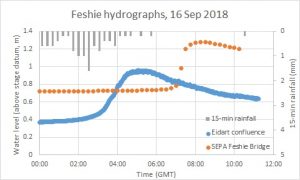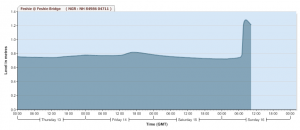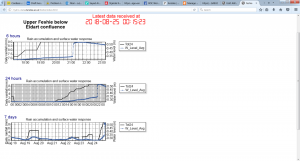We’re monitoring water levels on the upper River Feshie, and at two other sites lower downstream (and on some of the headwater tributaries too)! This is all nested within the catchment of SEPA’s gauge at Feshie Bridge, and will help provide a better understanding of the hydrology of this dynamic catchment.
Today, we have a hydrograph which has steepened as it travelled downstream, leading to a 400+mm rise at SEPA’s Feshie Bridge gauging station in 30 minutes. In the upper catchment the rainfall has been steady, rarely exceeding 4 mm/hr, leading to a fairly gradual rise.
We’ve seen the opposite situation earlier in the summer: steep hydrographs in the headwaters attenuating downstream, notably a 150 mm rise in 3 minutes which was barely noticeable once it made its way downstream to Feshie Bridge. I’m going to say nothing today about causes, but just mention in-channel friction, rainfall patterns, and gradients. Some hydrographs below to illustrate. More evidence to gather first.



Data at the upper Feshie (Eidart confluence) site are recorded every minute, providing a high level of detail, which is useful when examining rapid rises. Hydrologists working in the river, and walkers crossing the river on foot (there are no bridges on the upper river) need to be aware of the risk of rapid rises like these. Sometimes we hear stories of absolute walls of water – potentially lethal.
